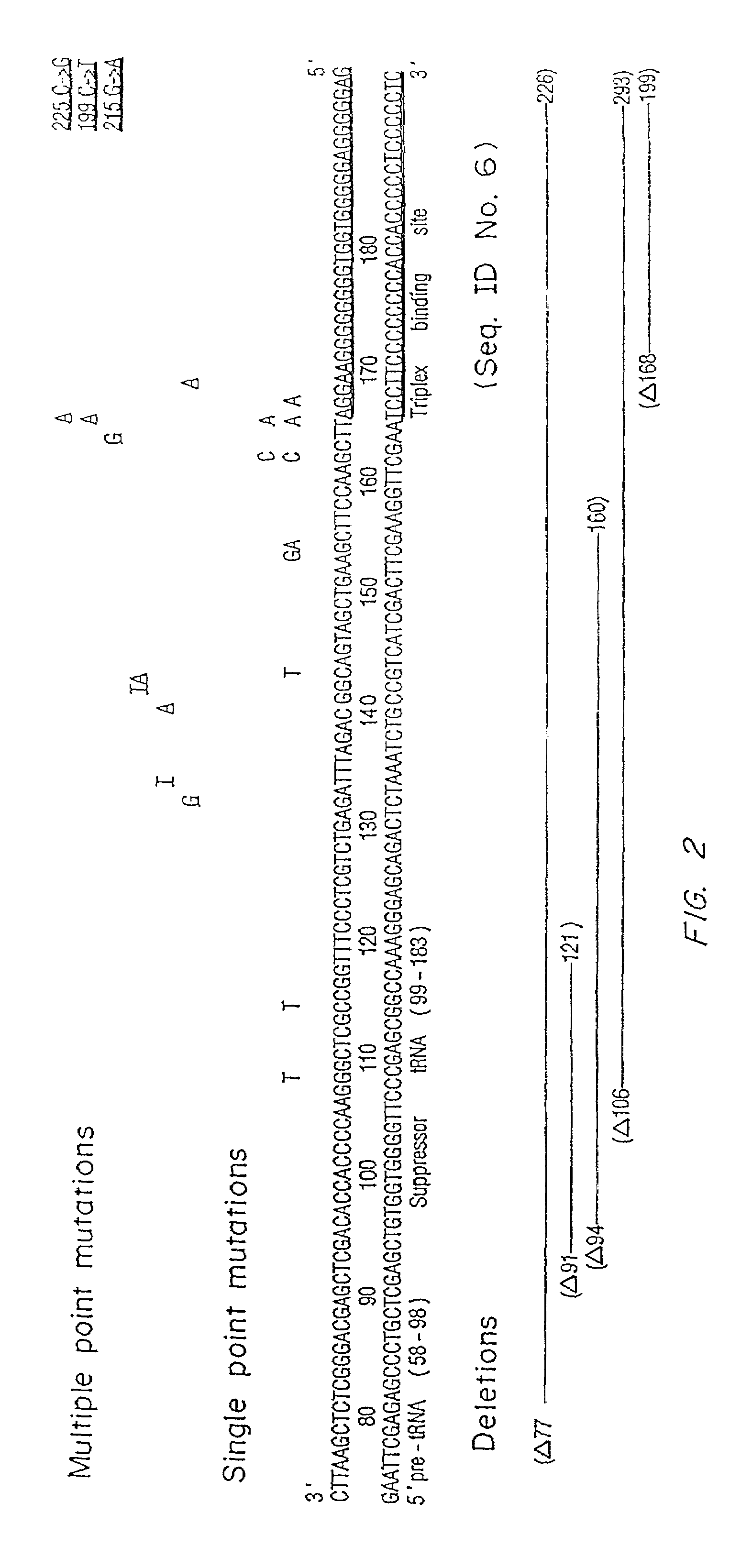Triple-helix forming oligonucleotides for targeted mutagenesis
a mutagenesis and oligonucleotide technology, applied in the field of triplehelix forming oligonucleotides for targeted mutagenesis, can solve the problems of complex delivery systems, low vivo efficiency, limited homologous integration frequency, etc., and achieve the effect of reducing the uncontrolled proliferation of cancer cells
- Summary
- Abstract
- Description
- Claims
- Application Information
AI Technical Summary
Benefits of technology
Problems solved by technology
Method used
Image
Examples
example 1
Targeted Mutagenesis using Non-Modified Oligonucleotides
[0056]PCT / US / 07234 by Yale University, describes the use of mutagen linked, triplex forming oligonucleotides (TFOs) in site-directed mutagenesis methods (herein incorporated by reference). It has now been observed that TFOs can target mutations in vivo in the absence of a linked mutagen. Experiments were conducted that demonstrate that treatment of mammalian cells with high affinity TFOs (Kd less than or equal to 2×10−8) which bind to duplex DNA, can generate mutations in a target gene within a cell. Triplex-induced mutagenesis was also tested in repair-deficient human cells derived from patients with xeroderma pigmentosum, both group A (XPA) and XP variant (XPV), in order to elucidate the role of repair pathways in the observed mutagenesis. In complementary experiments, the ability of intermolecular triple helices to stimulate repair synthesis in human cell extracts was investigated.
Materials and Methods.
[0057]Cells. Monkey CO...
example 2
Triplex Induced Recombination in HeLa Cell-Free Extracts
[0092]The ability of triplex formation to promote recombination with human cell-free extracts was tested using the following procedure.
[0093]Selected oligonucleotides were incubated with the target pSupFG1 / G144C vector in Hela whole cell extracts supplemented with nucleotides and ATP. Following a 2 hour incubation, the plasmid vector DNA was isolated and used to transform recA, lacZ(amber) indicator E. coli to score for supFG1 gene function. The bi-functional oligonucleotide A-AG30 (SEQ ID NO:9) was active in the extracts and produced supFG1-144 gene reversion at a frequency of 45×10−5. This effect occurred in the extract and was not mediated by recombination in the indicator bacteria, because, without incubation in the extract, no recombinant products were observed upon transformation of the A-AG30 (SEQ ID NO:9) sample into bacteria. The A donor fragment was also somewhat active, as co-mixture of A plus the pSupFG1 / G144C plasm...
example 3
Cell Extract Depletion and Assay
[0096]A. Using the in vitro cell extract system from Example 1 and Example 2, selected recombination and repair proteins in the pathway of triplex induced recombination were selected to determine their roles. HsRAD51 is a human RecA homolog that functions in homologous recombination and has been shown to mediate DNA pairing and strand exchange reactions. (Baumann, P. and West, S. C., 1998 Trends Biochem Sci 23(7), 247-251). Polyclonal rabbit anti-HsRAD51 antibody were used to deplete HsRAD51 protein from the cell extract. Successful depletion of HsRAD51 from the extract was confirmed by Western Blot. The depleted extract was tested for the ability to support triplex-induced recombination (Table 3), both in the case of the linked A-AG30 (SEQ ID NO:3) bi-functional molecule and in the case of the co-mixed separate A (SEQ ID NO:8) and AG30 (SEQ ID NO:3) sample. Immuno-depletion of HsRad51 was found to substantially reduce the frequency of recombinants in...
PUM
| Property | Measurement | Unit |
|---|---|---|
| Molar density | aaaaa | aaaaa |
| Fraction | aaaaa | aaaaa |
| Fraction | aaaaa | aaaaa |
Abstract
Description
Claims
Application Information
 Login to View More
Login to View More - R&D
- Intellectual Property
- Life Sciences
- Materials
- Tech Scout
- Unparalleled Data Quality
- Higher Quality Content
- 60% Fewer Hallucinations
Browse by: Latest US Patents, China's latest patents, Technical Efficacy Thesaurus, Application Domain, Technology Topic, Popular Technical Reports.
© 2025 PatSnap. All rights reserved.Legal|Privacy policy|Modern Slavery Act Transparency Statement|Sitemap|About US| Contact US: help@patsnap.com


